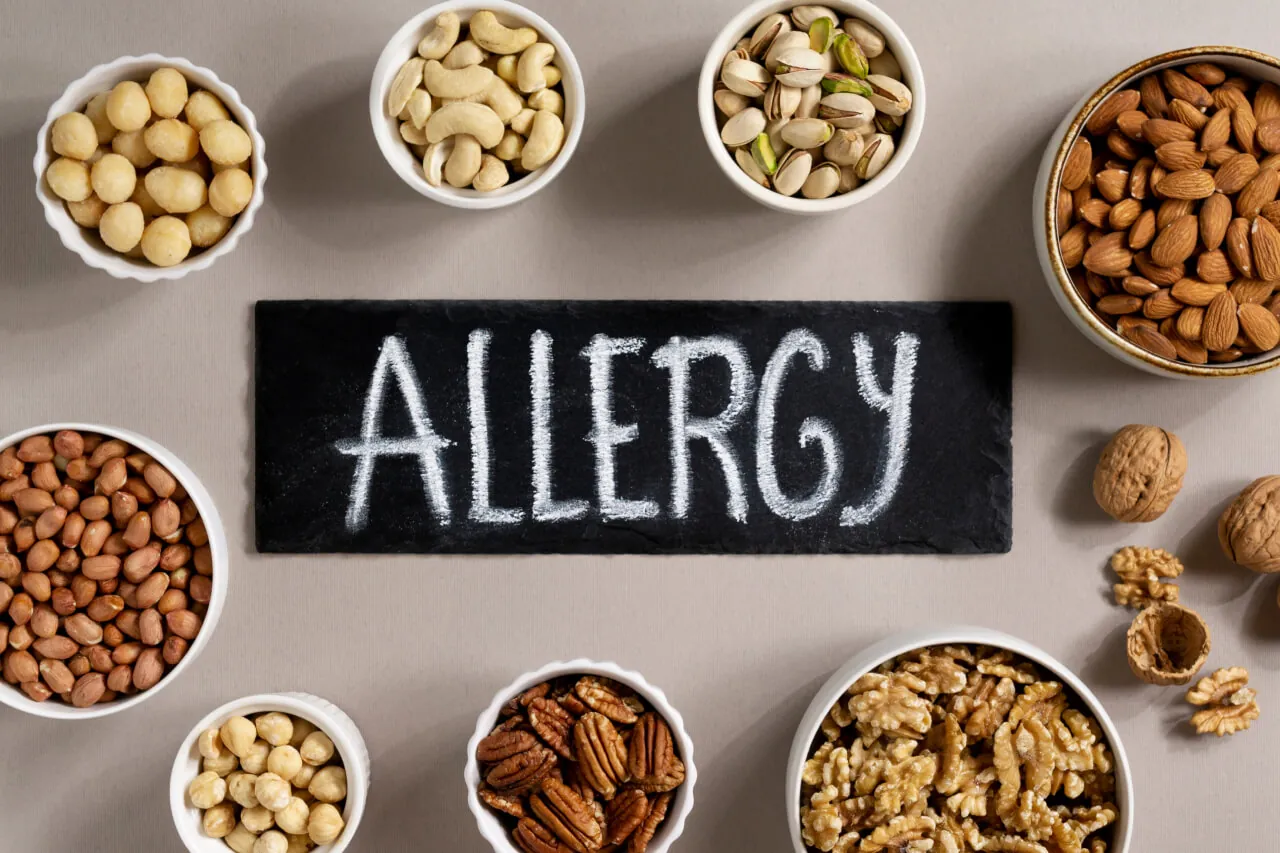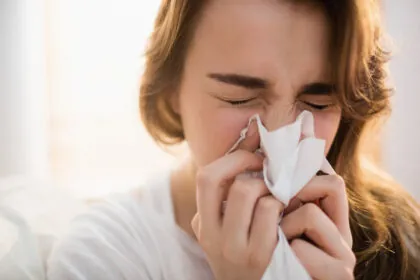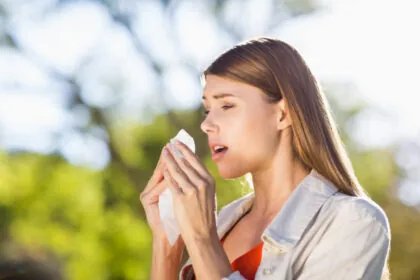Food allergies are a common and serious health issue that affects millions of people around the world.
According to the World Health Organization, food allergies affect about 250 million people globally, and cause about 150,000 hospitalizations and 200 deaths every year.
Food allergies can cause a range of symptoms, from mild to life-threatening, and can affect anyone, regardless of age, gender, or ethnicity.
But what exactly are food allergies, and what are the most common ones?
In this blog post, we will answer these questions and more, and provide some tips on how to manage and treat food allergies.
What is a food allergy?
A food allergy is a condition where the immune system reacts abnormally to a specific food or a component of a food, such as a protein.
The immune system mistakenly identifies the food as a harmful substance, and produces antibodies to fight it.
These antibodies trigger the release of chemicals, such as histamine, that cause inflammation and other symptoms in various parts of the body.
Food allergies can develop at any time in life, even if you have eaten the food before without any problems.
The severity and type of symptoms of food allergies can vary from person to person, and from one exposure to another.
Some people may have a mild reaction, such as itching or hives, while others may have a severe reaction, such as anaphylaxis, which is a life-threatening condition that can cause breathing difficulties, low blood pressure, and loss of consciousness.
Food allergy symptoms
The symptoms of food allergies can affect different parts of the body, such as the skin, the digestive system, the respiratory system, and the cardiovascular system.
The symptoms usually appear within minutes to hours after eating the food, but sometimes they can be delayed for up to several hours or even days.
Some of the common symptoms of a food allergy are:
- Skin rash, itching, hives, or swelling
- Nausea, vomiting, diarrhea, or abdominal pain
- Sneezing, runny nose, coughing, or wheezing
- Itchy or watery eyes, or conjunctivitis
- Headache, dizziness, or fainting
- Swelling of the lips, tongue, throat, or face
- Difficulty breathing, swallowing, or speaking
- Chest pain, palpitations, or low blood pressure
Some people may experience a severe allergic reaction, called anaphylaxis, which can be fatal if not treated immediately.
Anaphylaxis can cause the following symptoms:
- Difficulty breathing, due to swelling of the airways or throat
- Drop in blood pressure, leading to shock, fainting, or loss of consciousness
- Rapid or irregular heartbeat
- Loss of bladder or bowel control
- Confusion, anxiety, or panic
- Seizures or coma
If you or someone you know has any signs of anaphylaxis, call for emergency medical help right away, and administer an epinephrine injection if available.
Epinephrine is a medication that can reverse the symptoms of anaphylaxis by relaxing the muscles of the airways and constricting the blood vessels.
Types of food allergies
There are many foods that can cause allergic reactions, but some are more common than others.
According to the American Academy of Allergy, Asthma & Immunology, the following are the 10 most common food allergens:
1. Milk allergy
Milk allergy is one of the most common food allergies in children, affecting about 2% of them.
It usually develops in the first year of life and many children outgrow it by the age of 5.
Milk allergy is caused by an immune reaction to the proteins in cow’s milk, such as casein or whey.
It can cause symptoms such as hives, eczema, wheezing, vomiting, diarrhea, or anaphylaxis.
People with milk allergy should avoid all dairy products, such as cheese, yogurt, butter, cream, ice cream, and milk-based desserts.
They should also check the labels of processed foods, such as bread, cakes, cookies, cereals, sauces, soups, and snacks, as they may contain milk or milk derivatives.
2. Egg allergy
Egg allergy is another common food allergy in children, affecting about 1.5% of them.
It usually develops in the first year of life and many children outgrow it by the age of 10.
Egg allergy is caused by an immune reaction to the proteins in egg white or egg yolk, or both.
It can cause symptoms such as hives, eczema, wheezing, vomiting, diarrhea, or anaphylaxis.
People with egg allergy should avoid all foods that contain eggs or egg products, such as mayonnaise, custard, meringue, marshmallow, nougat, and some baked goods.
They should also check the labels of processed foods, such as bread, cakes, cookies, cereals, sauces, soups, and snacks, as they may contain eggs or egg derivatives.
3. Peanut allergy
Peanut allergy is one of the most common and severe food allergies in both children and adults, affecting about 1% of them.
It usually develops in childhood and persists throughout life.
Peanut allergy is caused by an immune reaction to the proteins in peanuts, which are legumes and not nuts. It can cause symptoms such as hives, eczema, wheezing, vomiting, diarrhea, or anaphylaxis.
People with peanut allergy should avoid all foods that contain peanuts or peanut products, such as peanut butter, peanut oil, peanut flour, peanut sauce, and some candies, chocolates, and snacks.
They should also check the labels of processed foods, as they may contain peanuts or peanut derivatives.
They should also be aware of the risk of cross-contamination, as peanuts may be present in foods that are prepared or served with other nuts or legumes.
4. Tree nut allergy
Tree nut allergy is another common and severe food allergy in both children and adults, affecting about 0.5% of them.
It usually develops in childhood and persists throughout life.
Tree nut allergy is caused by an immune reaction to the proteins in tree nuts, such as almonds, walnuts, pecans, pistachios, cashews, hazelnuts, macadamia nuts, brazil nuts, pine nuts, and chestnuts.
It can cause symptoms such as hives, eczema, wheezing, vomiting, diarrhea, or anaphylaxis.
People with tree nut allergy should avoid all foods that contain tree nuts or tree nut products, such as nut butters, nut oils, nut flours, nut milks, and some candies, chocolates, and snacks.
They should also check the labels of processed foods, as they may contain tree nuts or tree nut derivatives.
They should also be aware of the risk of cross-contamination, as tree nuts may be present in foods that are prepared or served with other nuts or legumes.
5. Soy allergy
Soy allergy is a common food allergy in children, affecting about 0.4% of them.
It usually develops in infancy or early childhood and many children outgrow it by the age of 10.
Soy allergy is caused by an immune reaction to the proteins in soybeans, which are legumes and not nuts.
It can cause symptoms such as hives, eczema, wheezing, vomiting, diarrhea, or anaphylaxis.
People with soy allergy should avoid all foods that contain soy or soy products, such as soy milk, soy sauce, soy yogurt, tofu, tempeh, edamame, miso, natto, and some meat alternatives, cereals, sauces, soups, and snacks.
They should also check the labels of processed foods, as they may contain soy or soy derivatives.
They should also be aware of the risk of cross-contamination, as soy may be present in foods that are prepared or served with other nuts or legumes.
6. Wheat allergy
Wheat allergy is a common food allergy in children, affecting about 0.4% of them.
It usually develops in infancy or early childhood and many children outgrow it by the age of 5.
Wheat allergy is caused by an immune reaction to the proteins in wheat, such as gluten, gliadin, or albumin.
It can cause symptoms such as hives, eczema, wheezing, vomiting, diarrhea, or anaphylaxis.
People with wheat allergy should avoid all foods that contain wheat or wheat products, such as bread, pasta, couscous, semolina, spelt, crackers, cereals, sauces, soups, and snacks.
They should also check the labels of processed foods, as they may contain wheat or wheat derivatives.
They should also be aware of the risk of cross-contamination, as wheat may be present in foods that are prepared or served with other grains.
7. Fish allergy
Fish allergy is a common food allergy in adults, affecting about 0.4% of them.
It usually develops in childhood or adulthood and persists throughout life.
Fish allergy is caused by an immune reaction to the proteins in fish, such as cod, salmon, tuna, herring, mackerel, sardines, anchovies, and trout.
It can cause symptoms such as hives, eczema, wheezing, vomiting, diarrhea, or anaphylaxis.
People with fish allergy should avoid all foods that contain fish or fish products, such as fish oil, fish sauce, fish stock, and some seafood dishes, such as paella, bouillabaisse, and sushi.
They should also check the labels of processed foods, as they may contain fish or fish derivatives.
They should also be aware of the risk of cross-contamination, as fish may be present in foods that are prepared or served with other seafood.
8. Sulfite allergy
Sulfite allergy is a rare but potentially severe food allergy, affecting about 0.01% of the population.
It usually develops in adulthood and may persist throughout life.
Sulfite allergy is caused by an immune reaction to sulfites, which are chemicals that are used as preservatives, antioxidants, or bleaching agents in some foods and drinks.
Sulfites can be found naturally in some foods, such as wine, beer, vinegar, dried fruits, and some seafood, or added artificially to some foods, such as canned foods, frozen foods, processed foods, and medications.
Sulfites can cause symptoms such as hives, eczema, wheezing, vomiting, diarrhea, or anaphylaxis.
People with sulfite allergy should avoid all foods and drinks that contain sulfites or sulfite products, such as sodium sulfite, sodium bisulfite, sodium metabisulfite, potassium sulfite, potassium bisulfite, and potassium metabisulfite.
They should also check the labels of processed foods and medications, as they may contain sulfites or sulfite derivatives.
They should also be aware of the risk of cross-contamination, as sulfites may be present in foods and drinks that are prepared or served with other foods and drinks that contain sulfites.
9. Mustard allergy
Mustard allergy is another relatively rare but emerging food allergy, affecting about 0.05% of the population.
It usually develops in childhood or adulthood and may persist throughout life.
Mustard allergy is caused by an immune reaction to the proteins in mustard seeds, mustard oil, or mustard sauce.
It can cause symptoms such as hives, eczema, wheezing, vomiting, diarrhea, or anaphylaxis.
People with mustard allergy should avoid all foods that contain mustard or mustard products, such as mustard greens, mustard powder, mustard dressing, mustard soup, and some condiments, such as ketchup, mayonnaise, barbecue sauce, and salad dressing.
They should also check the labels of processed foods, as they may contain mustard or mustard derivatives.
They should also be aware of the risk of cross-contamination, as mustard may be present in foods that are prepared or served with other spices or herbs.
10. Kiwi allergy
Kiwi allergy is a rare but potentially severe food allergy, affecting about 0.02% of the population.
It usually develops in childhood or adulthood and may persist throughout life.
Kiwi allergy is caused by an immune reaction to the proteins in kiwi fruit, kiwi peel, or kiwi seeds.
It can cause symptoms such as hives, eczema, wheezing, vomiting, diarrhea, or anaphylaxis.
People with kiwi allergy should avoid all foods that contain kiwi or kiwi products, such as kiwi juice, kiwi jam, kiwi yogurt, and some desserts, such as fruit salad, smoothies, and pies.
They should also check the labels of processed foods, as they may contain kiwi or kiwi derivatives.
They should also be aware of the risk of cross-reactivity, as kiwi may cause allergic reactions in people who are also allergic to latex, bananas, avocados, or chestnuts.
These 10 foods account for about 90% of all food allergy reactions, but other foods can also cause allergies, such as fruits, vegetables, spices, seeds, and meats.
The prevalence and types of food allergies can vary depending on the region, culture, and dietary habits of the population.
Some people may have more than one food allergy, or a cross-reactivity to other foods that share similar proteins.
For example, people who are allergic to peanuts may also react to other legumes, such as beans, peas, and lentils. People who are allergic to fish may also react to shellfish, or vice versa.
People who are allergic to birch pollen may also react to fruits and vegetables, such as apples, pears, carrots, and celery.
When do I know I have food allergies?
The only way to know for sure if you have symptoms of allergies is to see a doctor and get tested.
A doctor can diagnose food allergies by taking your medical history, performing a physical examination, and conducting some tests, such as a skin prick test, a blood test, or an oral food challenge.
A skin prick test involves placing a small amount of the suspected food allergen on your skin, and then pricking it with a needle.
If you are allergic, you will develop a red, itchy bump at the site of the prick within 15 to 20 minutes.
A blood test involves taking a sample of your blood and measuring the level of antibodies that your immune system produces against the food allergen.
A high level of antibodies indicates that you are allergic.
An oral food challenge involves eating a small amount of the suspected food allergen under medical supervision, and observing for any symptoms.
This is the most accurate way to diagnose a food allergy, but it can also be risky, as it may trigger a severe reaction.
Therefore, it should only be done by a trained specialist in a hospital or clinic.
How to treat food allergies
Unfortunately, there is no cure for food allergies, and the only way to prevent an allergic reaction is to avoid the food that causes it.
This means reading food labels carefully, asking about the ingredients and preparation methods of food when eating out, and carrying an epinephrine auto-injector if you have a history of anaphylaxis.
If you accidentally eat a food that you are allergic to, you should seek medical attention as soon as possible, and take antihistamines or epinephrine as prescribed by your doctor.
Antihistamines can help reduce the symptoms of a mild to moderate reaction, such as itching, hives, or sneezing.
Epinephrine can help reverse the symptoms of a severe reaction, such as anaphylaxis.
However, epinephrine is not a substitute for medical care, and you should still go to the hospital or call for emergency help after using it.
Some people may benefit from immunotherapy, which is a treatment that aims to desensitize the immune system to the food allergen.
Immunotherapy involves exposing the person to gradually increasing doses of the food allergen, either orally, sublingually, or epicutaneously, over a period of time.
This can help reduce the severity and frequency of allergic reactions, and improve the quality of life of the person.
However, immunotherapy is not a cure, and it does not work for everyone. It also carries some risks, such as anaphylaxis, and it should only be done under the guidance of a qualified allergist.
Conclusion
Food allergies are a common and serious health problem that can affect anyone, regardless of age, gender, or ethnicity.
Food allergies can cause a range of symptoms, from mild to life-threatening, and can be triggered by many foods, but some are more common than others.
The only way to prevent an allergic reaction is to avoid the food that causes it, and to seek medical help if you have one.
Some people may benefit from immunotherapy, which can help reduce the sensitivity to the food allergen, but it is not a cure.
If you or someone you know has food allergies, you should consult a doctor and get tested, and follow the advice and treatment plan that they prescribe.
You should also educate yourself and others about food allergies, and how to recognize and manage them.
By doing so, you can live a safer and healthier life.
FAQs
What are the most common food allergies?
The top 10 most common food allergies include milk, eggs, peanuts, tree nuts, soy, wheat, fish, shellfish, sesame seeds, and sulfites.
How do I know if I have a food allergy?
Symptoms vary, but common signs include hives, itching, swelling, abdominal pain, and difficulty breathing.
An allergist can conduct tests to diagnose food allergies.
Can food allergies develop later in life?
Yes, it’s possible for food allergies to develop at any age.
Some allergies may emerge during adulthood, even if the individual had previously consumed the allergen without issues.
Are there any treatments for food allergies?
While there’s no cure, people with food allergies manage symptoms by avoiding allergens and carrying epinephrine injectors for emergencies.
Research on immunotherapy is ongoing.
Can food allergies be outgrown?
Some children may outgrow allergies to milk, eggs, soy, and wheat, but allergies to peanuts, tree nuts, fish, and shellfish are often lifelong.
Regular testing can determine if an allergy persists.
What is cross-reactivity in food allergies?
Cross-reactivity occurs when proteins in one food resemble proteins in another, leading to an allergic reaction.
For example, individuals allergic to birch pollen may also react to certain fruits due to cross-reactivity.





